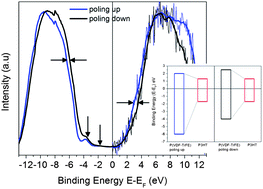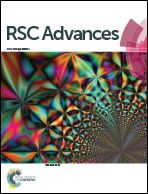Changing molecular band offsets in polymer blends of (P3HT/P(VDF–TrFE)) poly(3-hexylthiophene) and poly(vinylidene fluoride with trifluoroethylene) due to ferroelectric poling
Abstract
Photoelectron emission and inverse photoemission spectroscopy studies of polymer blends of poly(vinylidene fluoride (70%) – trifluoroethylene (30%)) P(VDF–TrFE 70 : 30) and regio-regular poly(3-hexylthiophene) (P3HT) provide evidence of changes in the molecular band offsets as a result of changes in the ferroelectric polarization in P(VDF–TrFE). Investigation of the blends with higher concentrations of the semiconducting P3HT component revealed that the organic semiconductor component of the blend dominates the electronic structure in the vicinity of the chemical potential. Specifically, the states of P3HT at the conduction band minimum and valence band maximum fall within the HOMO–LUMO gap of the dielectric ferroelectric P(VDF–TrFE) but the P3HT does not exhibit a change in the molecular band offset with respect to the Fermi level or band bending with polarization reversal, unlike P(VDF–TrFE).


 Please wait while we load your content...
Please wait while we load your content...